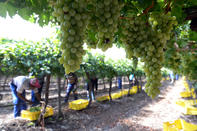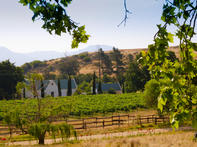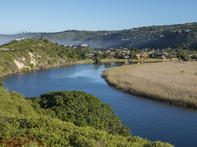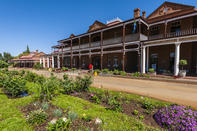Discover the Breede River Valley
This is where it all seems to hang together - the vines, the oak trees, the whitewashed houses and even the red and white roses planted next to the vines.

Nature reserves in the area offer guided trails for short walks or extended hikes. Horse or wagon rides through several of the wine estates offers something different.
Breede River Valley Attractions

The Breede River Valley region is the largest of the three wine and fruit-producing valleys in the Western Cape. The Valley is also famous for its breathtaking passes: Bain's Kloof, Du Toit's Kloof, Gydo, Hex River, Cogmans Kloof, Michell's Pass, Nuwekloof Pass and Theronsberg Pass.
Tulbagh has been faithfully restored to its old-world splendour after an earthquake in 1969. Visitors can walk along the Oude Kerk Volksmuseum complex, visit De Oude Drostdy Museum or go on one of the many trails in the area.
Worcester is the largest wine-producing district in the country. The historic Church Street is one of the best preserved street complexes in the country. A museum depicting the history of the Institute for the Blind opened in September 1997. At the workshops for the visually and hearing impaired, handmade cane furniture and weaving as well as other handicrafts are sold. Visitors are welcome to visit the Institute for the Deaf.
Ceres, named after the Roman goddess of fertility, is South Africa's most important deciduous fruit and fruit-juice producing district. Visitors can go on tours to various fruit co-ops and farms, as well as go raspberry, blackberry and cherry picking in season. The Kagga Kamma Nature Reserve is home to the last few Khoi and San in South Africa. Visitors to the reserve can also go on game drives.Hex River Valley

At the Kleinplasie Living Open-Air Museum in Worcester, tourists can watch activities such as baking, harvesting, candle-making and shearing. There is a huge collection of farming artefacts, a steam train, steam tractors and engines. De Doorns is the centre of the Hex River Valley, which produces most of the country's export grapes. Visitors can view the Cape Dutch homesteads scattered throughout the valley, the De Doorns Wine Cellar and a rose garden cultivating 150 000 rose trees annually in over 400 varieties.
The Astronomical Survey Monument in Touws River serves as a reminder of the British expedition that studied the transit of Venus in 1882. Mountain bike and hiking trails are available, and Khoi and San paintings can be viewed in the area.
So Much to Explore

Robertson in the Western Cape is the largest wine-producing area under irrigation in the Western Cape. Except for outdoor activities such as biking trails, hiking trails, canoe adventures, guided horse trails, 4x4 routes and rock climbing, visitors can also view fynbos and proteas in the Dassieshoek Nature Reserve and Pat Busch Private Nature Reserve. There are many farm stalls, an arts and craft route and a wine route with 21 members.
The KWV Brandy Cellar is the largest brandy distillery of its kind in the world. McGregor is the starting point of the Boesmanskloof Trail between McGregor and Greyton. The area offers a variety of hiking trails as well as the McGregor Village Walk. Montagu is known for its healing, hot mineral springs, tractor or trailer rides to the summit of the Langeberg Mountains and muscadel wines. There are opportunities for rock climbing, hiking, birdwatching and 4x4 routes.
Prince Alfred Hamlet is the gateway to Gydo Pass, offering spectacular views of the Ceres basin. Fruit tours, trout-fishing, mountain-biking and hiking are on offer. Bonnievale has two large wine estates, four co-operatives and two private wine cellars. Visitors can also visit the largest cheese factory in South Africa. Angling, boat and canoe trips on the Breede River are available.
 The Cape winelands have gentle hills and sea views in Constantia and Durbanville and great mountain peaks dominating Stellenbosch and Paarl....
The Cape winelands have gentle hills and sea views in Constantia and Durbanville and great mountain peaks dominating Stellenbosch and Paarl.... Head across the magnificent Du Toitskloof Mountains and the vine-clad expanse of the Breede River Valley onto Route 62 , and you’ll experi...
Head across the magnificent Du Toitskloof Mountains and the vine-clad expanse of the Breede River Valley onto Route 62 , and you’ll experi...